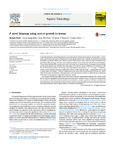A novel bioassay using root re-growth in Lemna.
| dc.contributor.author | Park, A | en |
| dc.contributor.author | Kim, Y-J | en |
| dc.contributor.author | Choi, E-M | en |
| dc.contributor.author | Brown, MT | en |
| dc.contributor.author | Han, T | en |
| dc.date.accessioned | 2015-12-10T14:07:22Z | |
| dc.date.available | 2015-12-10T14:07:22Z | |
| dc.date.issued | 2013-09-15 | en |
| dc.identifier.uri | http://hdl.handle.net/10026.1/3921 | |
| dc.description.abstract |
A new phytotoxicity test method based on root elongation of three Lemna species (Lemna gibba, L. minor, and L. paucicostata) has been developed. Tests with aquatic plants have, typically, favored measurements on fronds (e.g. frond number, area, biomass) rather than on roots, due, in part, to issues associated with handling fragile roots and the time-consuming procedures of selecting roots with identical root lengths. The present method differs in that roots were excised prior to exposure with subsequent measurements on newly developed roots. Results show that there were species-specific difference in sensitivity to the five metals tested (Ag, Cd, Cr, Cu and Hg), with Ag being the most toxic (EC50=5.3-37.6 μgL(-1)) to all three species, and Cr the least toxic for L. gibba and L. minor (1148.3 and 341.8 μgL(-1), respectively) and Cu for L. paucicostata (470.4 μgL(-1)). Direct comparisons were made with measurements of frond area, which were found to be less sensitive. More generally, root re-growth was shown to reflect the toxic responses of all three Lemna species to these five important metals. The root growth bioassay differs from three internationally standardized methods (ISO, OCED and US EPA) in that it is completed in 48 h, the required volume of test solutions is only 3 ml and non-axenic plants are used. Our results show that the Lemna root method is a simple, rapid, cost-effective, sensitive and precise bioassay to assess the toxic risks of metals and has practical application for monitoring municipal and industrial waste waters where metals are common constituents. | en |
| dc.format.extent | 415 - 424 | en |
| dc.language | eng | en |
| dc.language.iso | eng | en |
| dc.subject | L. minor | en |
| dc.subject | L. paucicostata | en |
| dc.subject | Lemna gibba | en |
| dc.subject | Metals | en |
| dc.subject | Root growth | en |
| dc.subject | Araceae | en |
| dc.subject | Biological Assay | en |
| dc.subject | Plant Roots | en |
| dc.subject | Toxicity Tests | en |
| dc.subject | Water Pollutants, Chemical | en |
| dc.title | A novel bioassay using root re-growth in Lemna. | en |
| dc.type | Journal Article | |
| plymouth.author-url | https://www.ncbi.nlm.nih.gov/pubmed/23917640 | en |
| plymouth.volume | 140-141 | en |
| plymouth.publication-status | Published | en |
| plymouth.journal | Aquat Toxicol | en |
| dc.identifier.doi | 10.1016/j.aquatox.2013.06.004 | en |
| plymouth.organisational-group | /Plymouth | |
| plymouth.organisational-group | /Plymouth/Faculty of Science and Engineering | |
| plymouth.organisational-group | /Plymouth/REF 2021 Researchers by UoA | |
| plymouth.organisational-group | /Plymouth/REF 2021 Researchers by UoA/UoA06 Agriculture, Veterinary and Food Science | |
| plymouth.organisational-group | /Plymouth/Research Groups | |
| plymouth.organisational-group | /Plymouth/Research Groups/Marine Institute | |
| dc.publisher.place | Netherlands | en |
| dcterms.dateAccepted | 2013-06-07 | en |
| dc.identifier.eissn | 1879-1514 | en |
| dc.rights.embargoperiod | 12 months | en |
| rioxxterms.versionofrecord | 10.1016/j.aquatox.2013.06.004 | en |
| rioxxterms.licenseref.uri | http://www.rioxx.net/licenses/under-embargo-all-rights-reserved | en |
| rioxxterms.licenseref.startdate | 2013-09-15 | en |
| rioxxterms.type | Journal Article/Review | en |


